A simultaneous action programming game with dice chucking and bidding to fulfill contracts and gain upgrades
90 minutes
Designer: Chris Antony
Artist:
Publisher: Good Games Publishing
In Guild Master, players are part of an adventuring guild striving to become the most famous guild around by recruiting adventurers and completed contracts. Throughout the game you’ll secretly assign your adventurers to various locations on the board to build upgrades, recruit other adventurers, or fulfill contracts for points and other benefits. But be careful, if an opponent also assigns an adventuring team to the same location it may come down to skill checks, bidding, or even negotiations to determine who gets the spot.
Note: Guild Master was generously provided to us by the publisher for a review. As always, we strive to be open and honest.
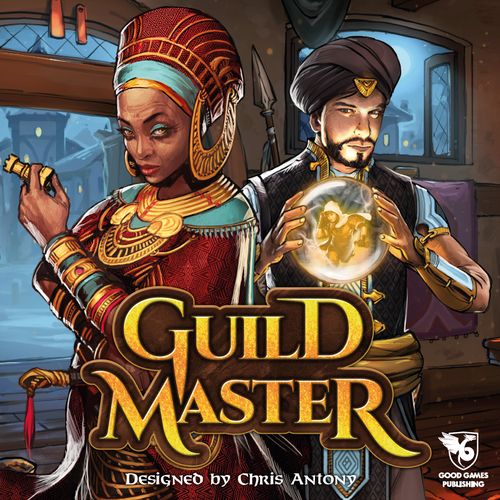
Gameplay Overview
This is a general overview to provide context for the review, not an in-depth how to play. Some rules might be glossed over or missing.
A game of Guild Master is played over 9 rounds, each round consisting of 5 phases. There is an option to play only 6 rounds as a “short” game if players don’t have as much time.
Setup
The table is set up with a central board that has the action spaces and displays adventurers and contracts up for grabs. The available upgrades are also displayed in a central location.
Each player sets up their own player area complete with a screen, upgrade mat, order mat, and a nifty ribbon all in their guild art. The guild they choose doesn’t impact the game (everyone plays by the same rules), but the art can get you in the right headspace.
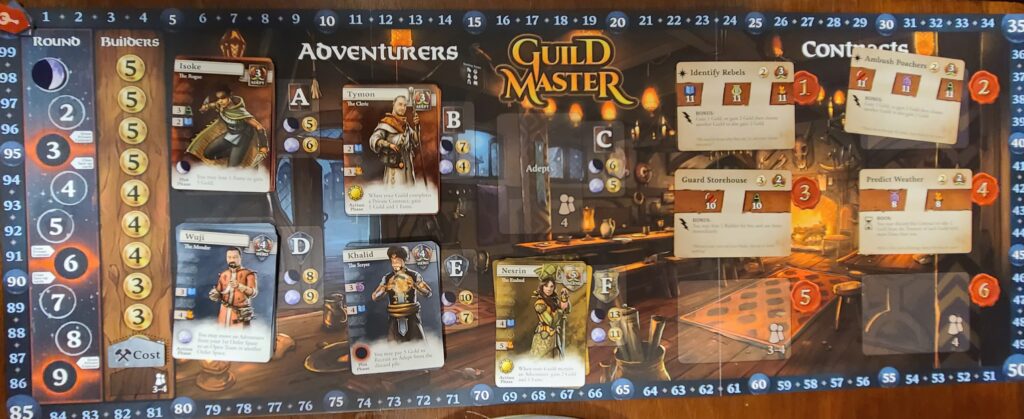
Round Overview
Each round has a TON going on and it seems like a lot at first. We found throughout the first game that the pieces all fit together, and by the end of our first playthrough it felt like a natural progression.
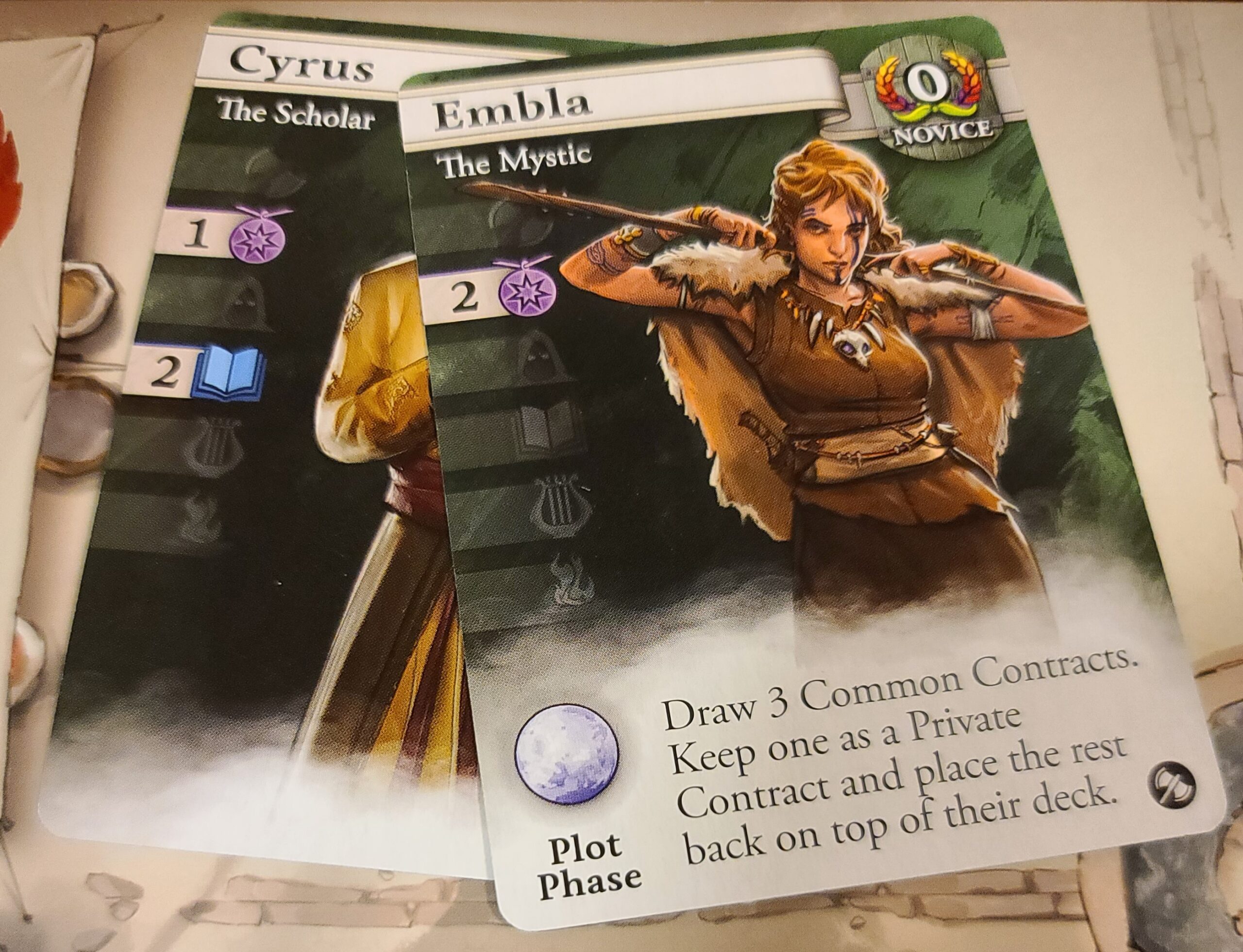
Phase I: Round Start
- Announce events from contracts (if present)
- During a blood moon round – each player draws a new private contract
Phase II: Plot Phase
Pro Tip: The plot phase abilities are easy to forget about or overlook throughout the game when you’re focused on other things, but they can be very powerful! There are also plot phase abilities that are used during the actions, so pay attention!
- Use plot phase abilities as instructed on adventurer cards
- Adventurers just need to be part of the guild (in your hand) to use plot phase actions, they do not need to be played
- Each player announces how much gold they have
- We always forget to do this, but it does impact game play
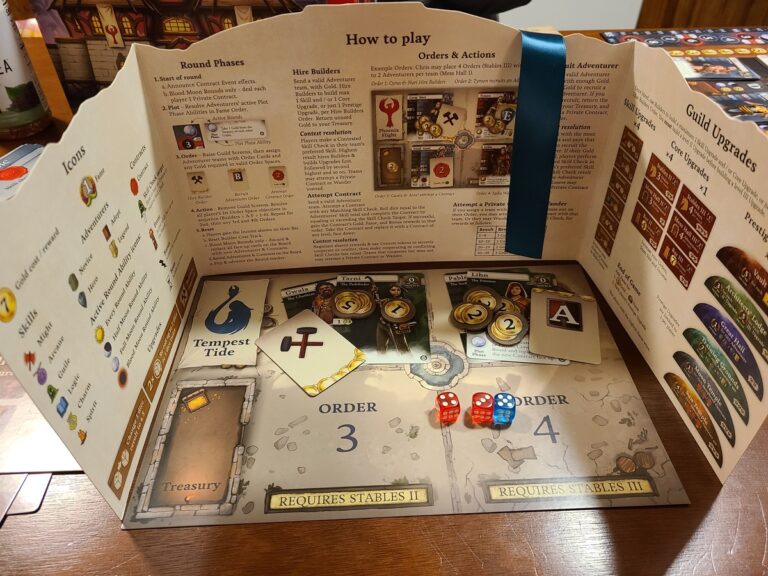
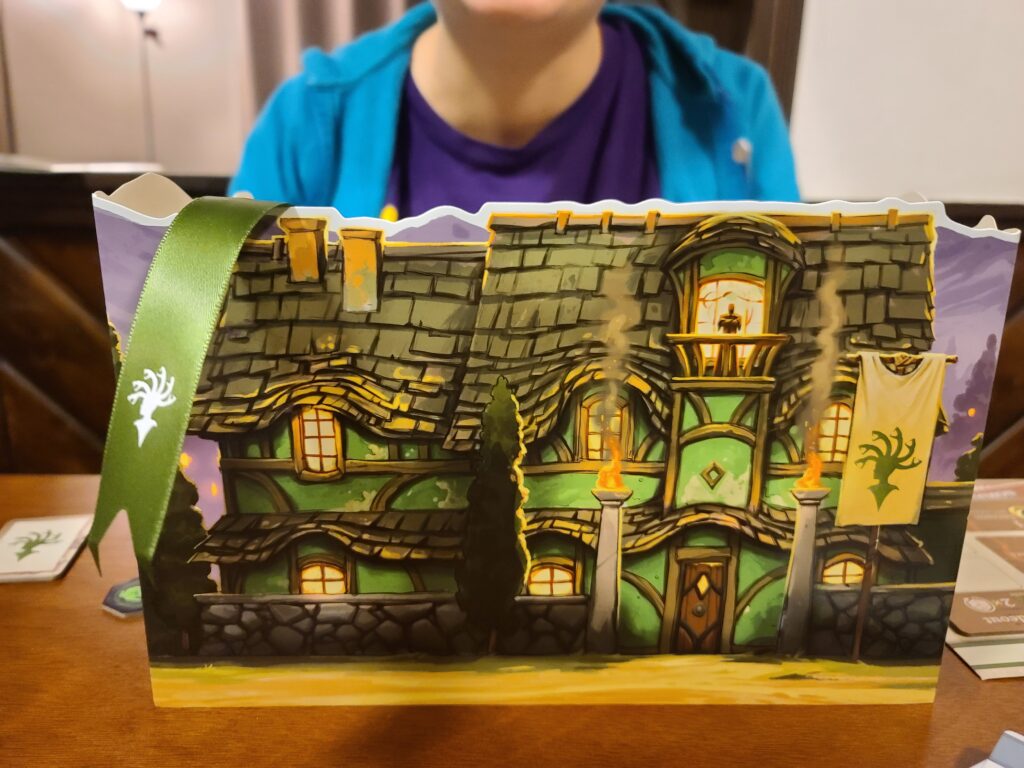
Phase III: Orders Phase
Quick Definition: The “order” defines what action that adventurer team will complete in this round. At the start of the game, you can assign up to 2 adventurers to a team, and you can assign orders to 2 teams.
- Set up player screen to hide money, adventurers, and orders
- Simultaneously assign orders and adventurer teams
- Throughout the game, players can get upgrades to access more orders and assign bigger adventurer teams
- When each player is done assigning orders and teams, they lay their guild ribbon over the screen to indicate they are ready to move on
Phase IV: Action Phase
- Lower player screens to reveal orders
- Swear (if the kids are in bed) when you see that someone is going to compete with you for a spot
- Cheer (regardless of child proximity) if you see that your orders are all uncontested and your strategy can play out
- Resolve orders and execute actions – this is the somewhat tricky part
- There is no “turn order”. Instead, all players check their first order and resolve them in the left-to-right sequence on the central board:
- Builders (get upgrades)
- Recruit Adventurers (action spaces A-F)
- Contracts (action spaces 1-6)
- OR a player might choose to resolve a private contract from their hand, or “wander” to get low-value rewards instead of completing their order. This is also an option if they lose out on the conflict resolution (below)
- When there’s a conflict (two players chose the same order), it’s resolved in different ways based on which type of order it was
- Note: There are a lot of rules around conflict resolution we won’t go into detail on here, but this is where a TON of interaction happens. In some cases there can be cooperation, bargaining, or even a bit of trickery
- When the first round of orders have ALL been resolved, players repeat the above for the second round and so on
- There is no “turn order”. Instead, all players check their first order and resolve them in the left-to-right sequence on the central board:
Phase V: Reset
- Remove assigned orders and adventurers
- Gain income
- Reset builder track
- During a Blood Moon phase: reset all face up cards
- Reveal new adventurers and contracts as applicable
- Move and flip round marker (half moon to full moon or vice versa)
End of Game
Play continues through the end of the 9th round which signals the end of the game. Players gain points throughout the game, and at the end can score additional points from prestige upgrades and remaining gold (5:1).
What do we think?
There is a lot happening in Guild Master. It sometimes feels like several mini games mashed together, and yet it somehow works.
We started out our first game a bit skeptical of how well it would work at 2-players. The “fun” part of the game is really in the interactivity and the fight over the best actions. While there isn’t as much direct head-to-head competition as we imagine there would be in a game with more players, there still was enough to make it fun and interesting. There’s something about enjoying a glass of wine while deliberately messing with your wife’s strategy that’s just oh so satisfying.
Guild Master for us is on the lighter side of medium weight. Dice determine whether a contract is completed or not, so there is a lot of luck involved, but players can heavily plan and strategize ways to buffer their luck. Strategic decisions around upgrades, adventurers, and contract bonuses give players a lot of control over their fate in a way that feels similar to other strategic dice games like Castles of Burgundy or Troyes.
What did we like?
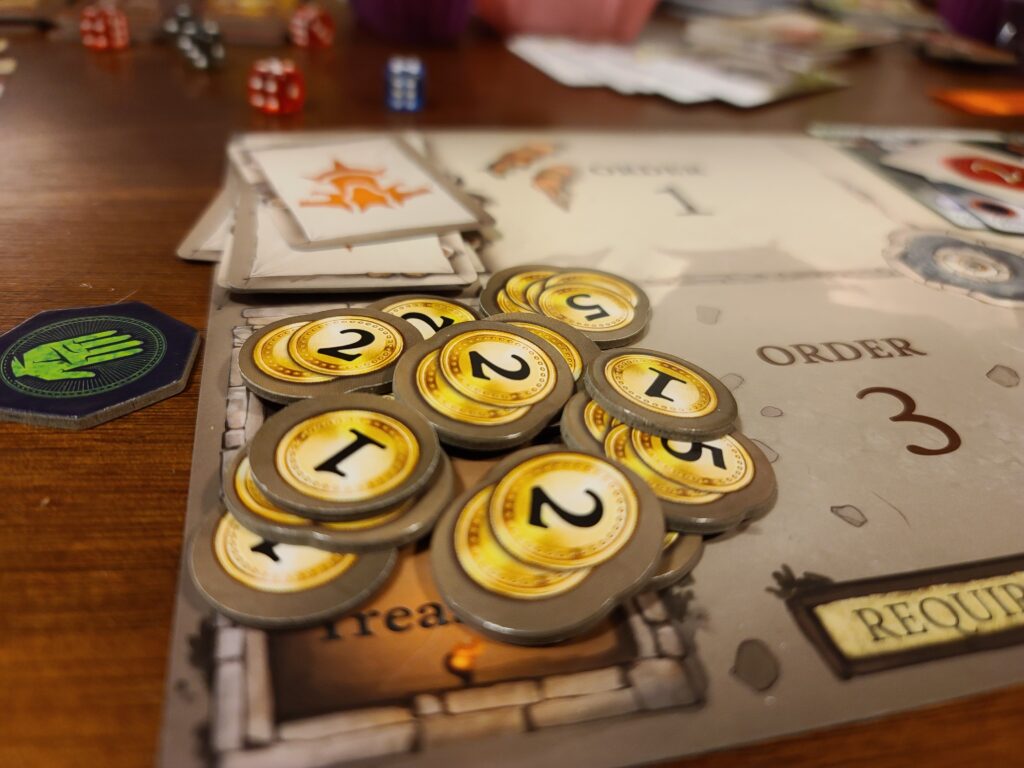
There is a lot to like about Guild Master. For us, it boils down to this hard to describe “fun” factor that Guild Master achieves. It’s competitive, but not in a way that’s infuriating (for us, it might differ if your game group is really aggressive). The part of the game that really shines for us is the theme integration. There are a lot of mechanisms in this game, but they all 100% make sense with the theme in a way that feels uniquely immersive in a way strategic games often struggle with. It’s easy to see how you are “sending” your adventurers off to complete various tasks. It also has a lot of nuance in the different plot actions, adventurer abilities, contract bonuses, and upgrades that means each game feels very different.
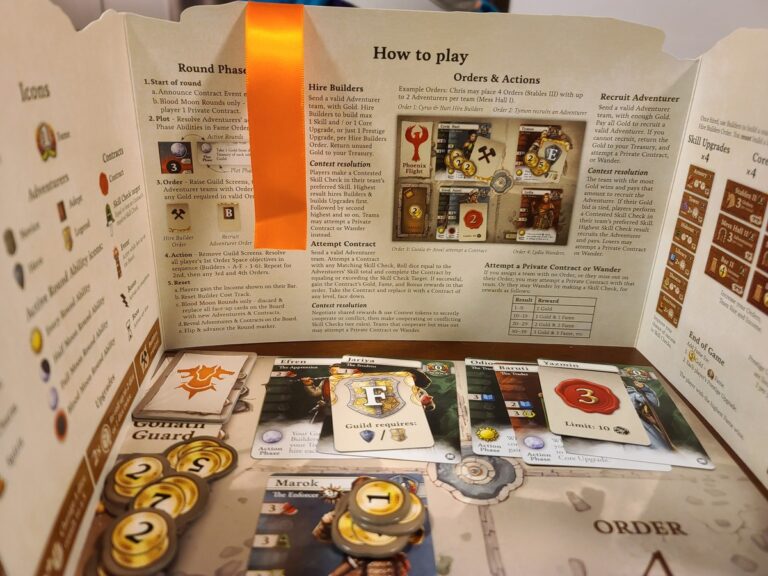
We also found it to be shockingly good at 2 players. Interactive games like this one rarely scale well, or they become a completely different (and often less fun) game at 2 compared to higher player counts. Even though we tend to be conflict-avoidant in most games, we still ended up with a lot of interaction that was tense enough to get emotionally invested without the frustration that might come with more aggressive interactive gameplay. That said, you can definitely get more aggressive (or even more avoidant) if it fits into your strategy and that flexibility might be part of what works so well at 2 players.
What didn't we like?
Part of what we like about this game – all the nuances and options – also comes with a drawback that this game is SUPER fiddly. There’s a lot of different card decks, upgrade piles, you’re putting the player shield up and down, you’re moving the ribbon around, you’re moving coins around and juggling a bunch of different types of cards. By the end of the game, our player areas and the table in general look like that time we played Pandemic Legacy and never cleaned it up between rounds (okay, okay not quite that bad, at least there’s no card ripping or stickers involved). We definitely have and love other games that are worse culprits, but in this weight class (medium-lightish), it can feel like a lot.
This is a pretty minor concern, since behind all these fiddly movements are game mechanics that work pretty smoothly and make sense.
The other minor complaint is that the plot phase actions are easy to overlook. For us, this was partly because some are so overly complicated that they can only be used in an extremely specific circumstance that can take a lot of effort to orchestrate. For both of us the plot phase abilities were typically used only if we just happened to have the right circumstances, rather than actively trying to create the right circumstances. On the other hand, some are very powerful so it’s a mixed bag that can make it a difficult mechanic to use (and remember to use in the right circumstance). This didn’t significantly impact our enjoyment of the game.
Who will like this game?
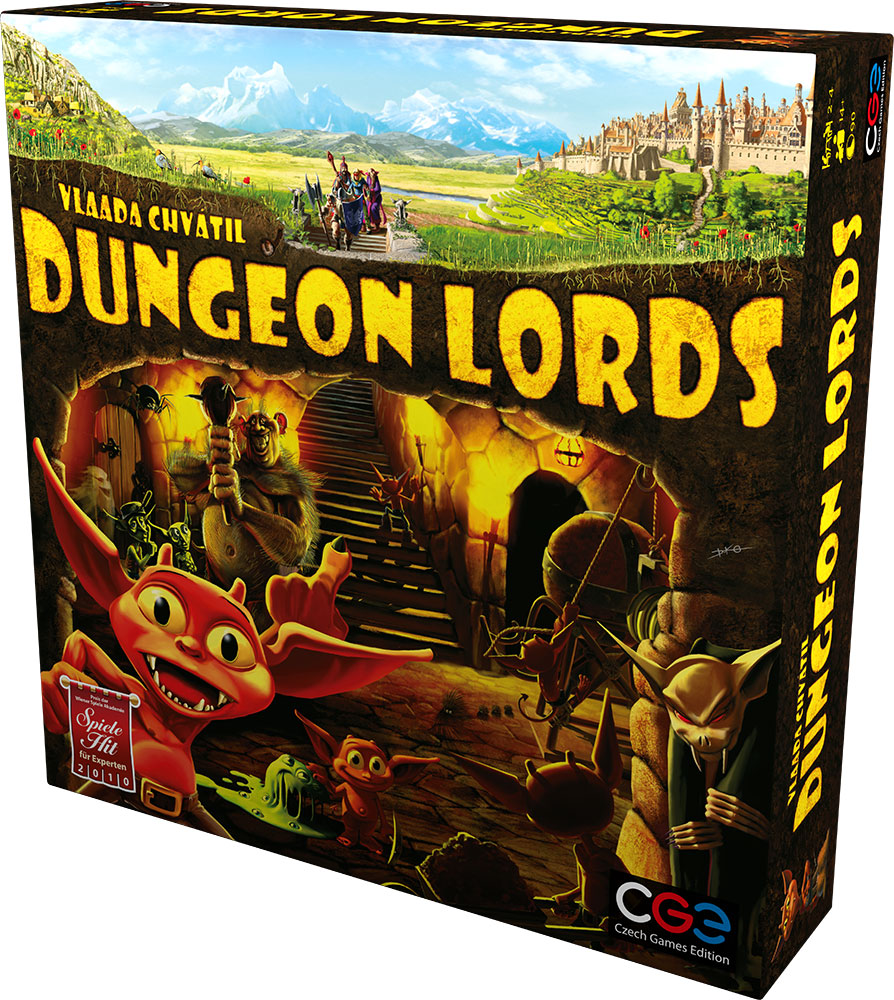
This is a unique game. As we mentioned above, it feels like several mini-games in one. There’s the well-defined fantasy theme that feels a bit like an RPG (but not), there’s the dice, the secret simultaneous action selection, bidding, etc. To us, the game has a “feel” similar to other highly interactive games, like Oceans, where success depends on being able to read the table and figure out what your opponents are thinking. The simultaneous action selection and fantasy theme remind us of a lighter-weight version of Dungeon Lords. The theme with the contract completion might be a good fit for fans of Lords of Waterdeep.
This game will be perfect for players who like a bit of strategy, a bit of luck, and a bit of interaction all rolled into one. We think it will probably be a better fit for somewhat experienced gamers. There are so many small rules that even thought it’s a mid-weight game, it’s likely going to be a challenge for anyone new to modern tabletop gaming. It would be a perfect “next step” for those who have already dipped their toes in with other gateway games and want something with a bit more challenge that is still super fun.
Sarah's Take
I know we’ve said this throughout the review, but Guild Master is just really fun. It sort of reminds me of the first time we played D&D and we just ran around the map all carefree and checking everything out. True, we were immediately attacked by a gaggle of goblins, but we were laughing and having a grand ole time. Don’t get me wrong, you can’t be carefree or lack a plan in Guild Master, but there are so many things to do an explore that it invites a really similar feeling for me.
Guild Master is a game that also lets me mess with Emily without really hurting my plan (honestly, I rarely have a plan because I get distracted by all the shiny). If there’s a big contract on the board that I know she has good odds of completing I am going to throw down and try to make her split it with me.
I also dig that the rulebook has a probability table in the back, and let me tell you, the odds of rolling a success are way lower than I thought. Maybe this is why I am in social work and not a field that requires math….
Emily's Take
I really love the unique solutions Guild Master has for competing for the same spot at the same time. We didn’t go into any depth on the resolutions for choosing the same action as an opponent, but having to resolve with rolls, bidding, or bargaining is unique and makes this game stand out in my mind. Sometimes we go on kicks where we play a lot of similar games in a row, and some games muddle together in my head (wait is that the worker placement Euro with bland artwork set in idyllic medieval France or idyllic medieval England?). Guild Master stands out on our shelf – the theme, the mix of game mechanics that shouldn’t work but totally do, the art.
Also, Sarah can be very predictable at times and it took several plays for her to figure out how to change up her strategy to throw me off so I don’t thwart her plans. She has yet to beat me and that might be what I love most of all. Mwahaha.
Rulebook / Learning the game
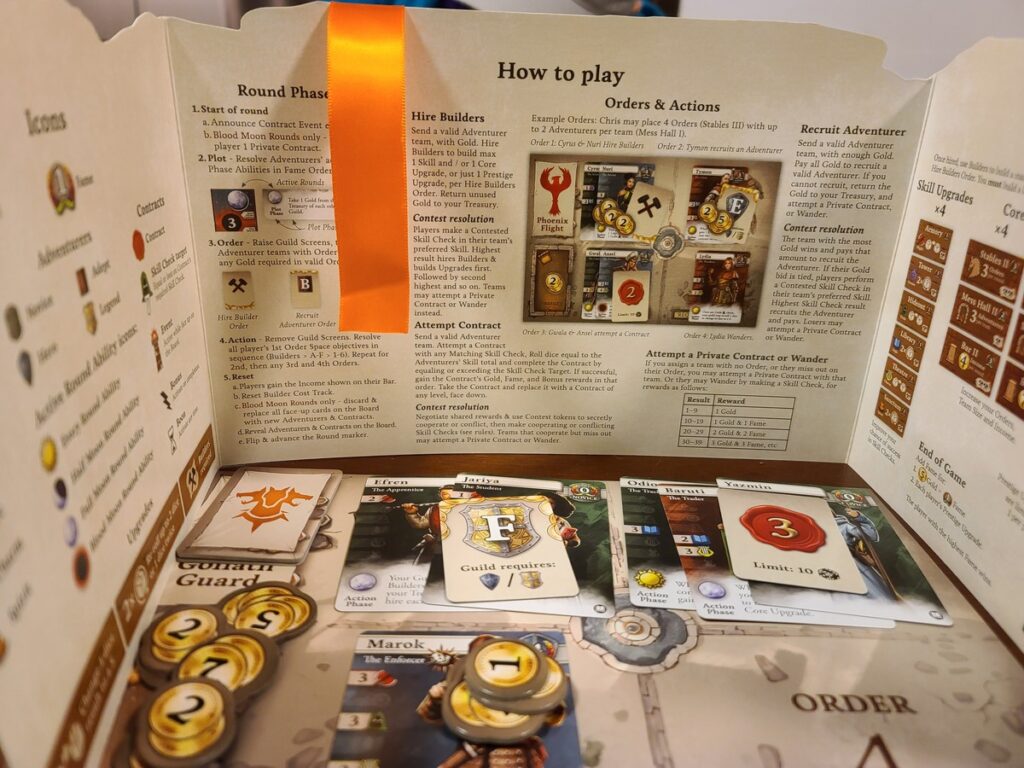
Guild Master has one of the more challenging rule books that we have encountered recently. There is a lot going on in this game and a lot to keep track of, so naturally, that translated into a rulebook chock full of words.
The rulebook is also laid out in a way that it starts explaining some game concepts before entirely explaining the game play making it a bit more challenging to learn from. We learn best by getting an overview for how the game is played before delving into concepts, but that is somewhat personal preference. Once you know and understand the flow of the game, the rulebook makes sense and it isn’t too much work to look things up.
Guild Master also comes with a Quick Start guide for the first game, but we didn’t find it as helpful as it seemed at first since it was set up for 4 and hard to adapt to 2 when we didn’t know how to play yet. BUT the player aid on the privacy screen is AMAZING.
First Play
Our first play was split up over 2 nights. The first night was spent mostly tackling the rulebook and the second night we finally got to playing. Once we made it through a few rounds we understood the gameflow and things moved smoothly. All the complexity that feels confusing when learning the game actually works very well when you’re playing. That’s probably the intent of the quick start guide, which walks you through the beginning of an example game. We didn’t really like the quick start guide and ended up skipping it entirely, but a short “learning” game where you muddle through a few rounds to get a feel for the phases is key, especially if no one at the table has played before.
We ended up rushing through our first game once we felt like we “got” it, and immediately wanted to play a second game.
Subsequent Plays
We mentioned above wanting to immediately set the game up again after our first play. Guild Master has so much content in the box that there are multiple strategies to explore and keep the game interesting.
The more we played, the more we appreciated the fun factor of Guild Master. Not every game has to wreck your brain and sometimes you just want to haggle over a contract with your wife.
Parent Perspective
Interruptions
This is a simultaneous game where programmed actions are executed out of turn order (there really is no turn order here) so an interruption will completely stop gameplay. It does become important to focus on timing and making sure that you’re sending the best adventurers to the right spots, so an interruption during the programming phase could really hinder your planning. The best time to take a break is between rounds if your distraction can wait a minute for you to get them a glass of milk.
Time Investment
The game itself can play pretty quick once you get the hang of all the steps in a round, about 30 minutes per player of playtime. But, uff-da, there sure are A LOT of components and things to set up and clean up, and most of them are different card decks! It does go pretty quick but it sure feels fiddly when there doesn’t actually seem to be that many things to set up. Tack on an extra 15min total for setup/cleanup.
Life Fit
Guild Master clocks in right at about 90 minutes for us so it’s definitely do-able on a weeknight as long as bedtime for the kiddos goes smoothly. There are a heck of a lot of steps in each round to remember, so if you’re not on your A game while tired or worn down from a day of Zoom meetings, probably best to leave this one on the shelf for a time when you’re feeling fresh. That said, the theme and the interaction do tend to liven up the game compared to some similar games, so it might wake you up a bit after a long day, especially if your wife beats you to a contract spot when she doesn’t need it and KNOWS YOU DO (**Sarah**).
Rating
7/10: Very Good
We have a ton of fun playing Guild Master. There aren’t a lot of games with this sort of interaction that work well at 2, which is part of what we like so much. The theme integration is great, and there are a lot of very satisfying moments of successful die rolls and outwitting your opponent (or getting lucky). Our rating reflects how it compares to our overall game library and experience. It’s definitely among the top games we might choose when we want to play an interesting, engaging mid-weight game.
*See our rating scale HERE
Click through for more posts, or follow us on social media to see what we’re playing and for new post updates!
